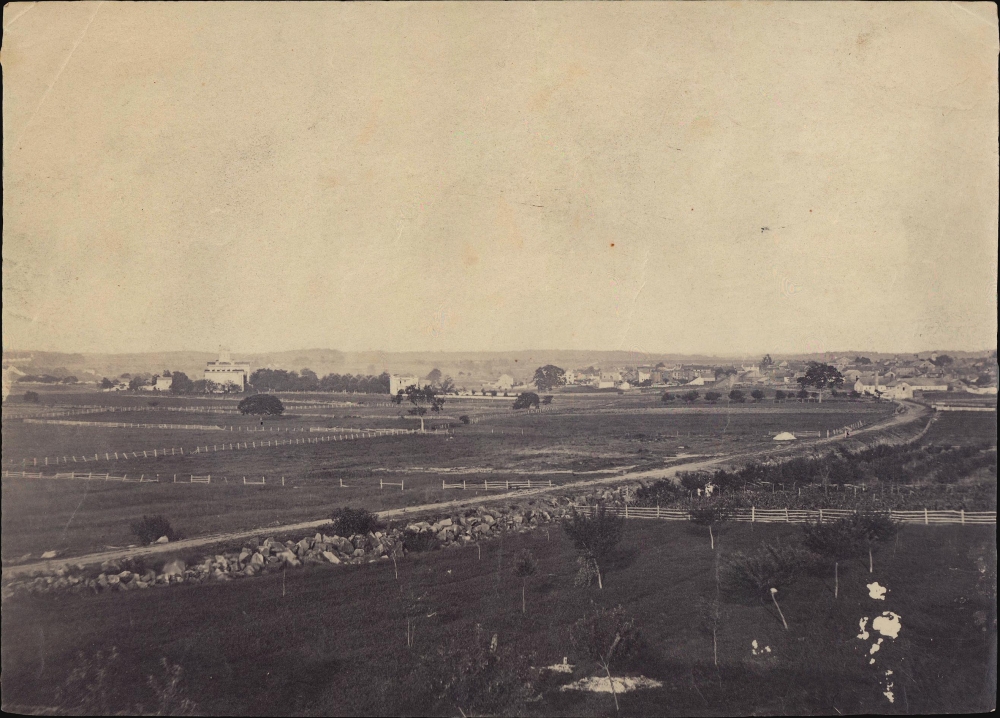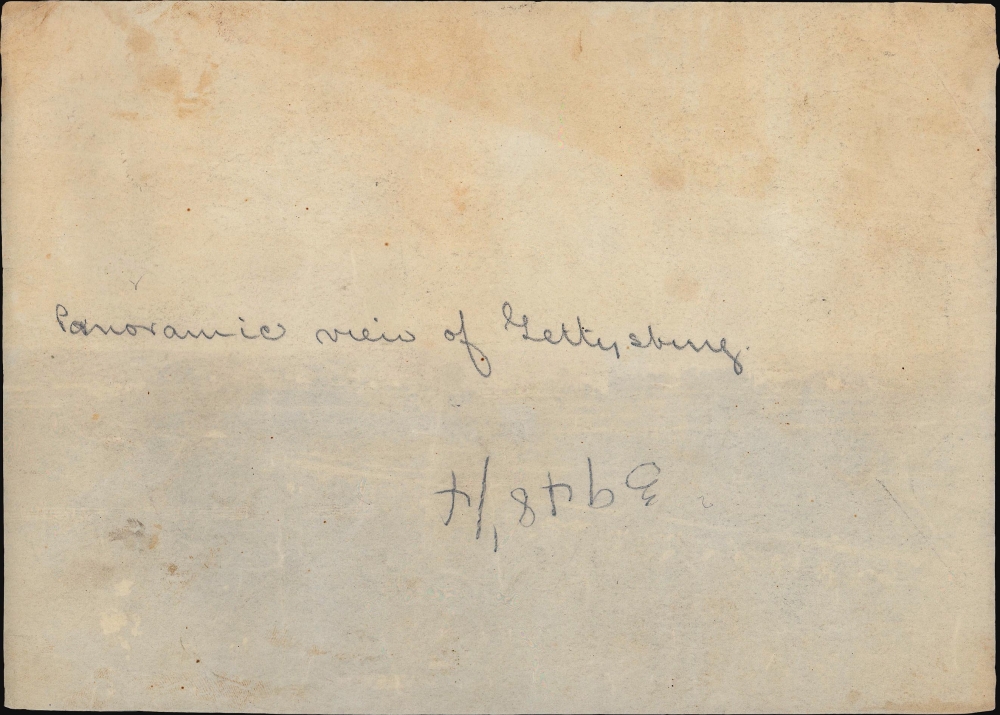This item has been sold, but you can get on the Waitlist to be notified if another example becomes available.
1863 O'Sullivan Albumen Photograph View of Gettysburg Battlefield from Seminary Ridge
GettysburgSeminaryRidge-osullivan-1863
Title
1863 (undated) 6.25 x 8.75 in (15.875 x 22.225 cm)
Description
A Closer Look
Looking east toward the town of Gettysburg from Seminary Ridge, trees, fences, fields, and the Railroad Cut in the foreground. The town of Gettysburg is visible in the background. The large building on the left is Pennsylvania Hall, which is now the central administration building of Gettysburg College.Mathew Brady and Civil War Photography
Mathew Brady (c. 1822-1824 - January 15, 1896) was a successful portraitist and photographer at the beginning of the American Civil War (1861 - 1865). At the outbreak of the war, he advertised his services to take portraits of soldiers leaving to fight, making popular cartes de visite. Soon, he realized the new technology could be used to document the events of the war.Brady's effort, into which he invested at least $100,000 of his own money, has dubbed him the 'first photojournalist.' He developed mobile dark rooms and other mobile photographic equipment to make this undertaking possible. Brady hired a cadre of over 20 photographers, developers, and other workers to assist with this task. Many of Brady's photographers, including Alexander Gardner, Timothy O'Sullivan, George Barnard, Egbert Guy Fowx, and Thomas C. Roche, took iconic photographs that resonate to this day. However, Brady took and copyrighted most of the images under his own name as 'Brady and Company'. This caused ruptures with some of his photographers (most notably the extremely talented Gardner), which had repercussions for the rest of his life. The 'myth' of Brady's photographic prowess overshadowed any successes by other photographers, whether they worked for him or not. To this day, most Civil War photography is attributed to Brady. Some have suggested, due to his failing eyesight, that he acted more as a director, making few of the field photographs himself. Historians generally see Brady's role as organizer, financier, advertiser, and entrepreneur. His insistence on using the 'Brady and Company' imprint on all images without giving credit to the individual photographers has complicated his legacy and made identifying specific photographers under the company umbrella challenging - if not impossible.
The Battle of Gettysburg
Fought from July 1st through the 3rd, 1863, the Battle of Gettysburg was the defining moment of the American Civil War (1861 - 1865). The Confederacy began the war by advancing aggressively and successfully under the brilliant generalship of Maj. General Robert E. Lee (1807 - 1870). Buoyed by his May 1863 successes at the Battle of Chancellorsville (April 30 - May 6, 1863), Lee launched a grand invasion of Pennsylvania, intending to push as far as Harrisburg, or potentially Philadelphia. The Union and Confederate forces first engaged at Gettysburg on July 1, 1863. The Confederates met with some initial success, seizing weakly defended but strategic ridges before reaching a stalemate. The Confederates decided to break the stalemate with an aggressive charge on the well-fortified Union position of Cemetery Ridge. Pickett's Charge, as it became known after its leader, Confederate Maj. Gen. George E. Pickett (1825 - 1875), was a disaster, incurring heavy losses and turning the tide of the battle. In subsequent engagements, Union forces again and again prevailed, forcing the Confederate army into a torturous retreat back to Virginia. The Battle of Gettysburg resulted in between 46,000 and 51,000 casualties, proving the costliest single battle in U.S. history. In the aftermath of the battle, on November 19, President Abraham Lincoln (1809 - 1865) issued the historic Gettysburg Address, redefining the purpose of the war. Pickett's Charge proved to be the Confederate high-water mark. Not only did the Confederacy lose the Battle of Gettysburg, but from this point forward, they also began to lose the war.Publication History and Census
This photograph was taken in 1863 by Timothy O'Sullivan. We note only one instance when a print of the present photograph appeared on the private market: a 2021 Christie's auction when the price realized was $4,375. We note a single cataloged example in institutional collections, which is part of the collection at the Metropolitan Museum of Art in New York City. The original glass negative is preserved at the National Archives.CartographerS
Timothy O'Sullivan (1840 - January 14, 1882) was an American photographer. Very little is known about is personal life. Even his place of birth remains a mystery: either he was born in Ireland, or his parents arrived in New York before his birth. The records to prove either theory do not exist. Our knowledge of O'Sullivan's life begins in his teens, when he apprenticed to New York based photographer Mathew Brady, who would become famous for his Civil War photographs. He soon moved to Washington, D.C. and worked in the Brady studio managed by Alexander Gardner (1821 - 1882). O'Sullivan claimed that he enlisted in the Union Army in 1861, but the records to support this claim have not been found. It is likely that he was given an honorary commission and worked copying maps and plans and took photographs as well. We know O'Sullivan worked with Brady and Alexander Gardner in 1861, and when Gardner left Brady's firm in 1862 O'Sullivan went with him. It is said Gardner left Brady's studio because of Brady's tendency to declare all photos to be taken by 'Brady and Co.' O'Sullivan worked with Gardner throughout the rest of the war and produced many of his most famous images during these years. Both men were at Gettysburg, photographed the Siege of Petersburg, and O'Sullivan was in North Carolina during the siege of Fort Fisher before ending the war at Appomattox Court House. After the war, O'Sullivan became a member of the United States Geological Exploration of the Fortieth Parallel led by Clarence King from 1867 until 1869. He was also part of Lt. George M. Wheeler's survey west of the 100th meridian from 1871 through 1874. O'Sullivan even traveled through the Grand Canyon on the Colorado River, although most of his negatives were lost during that journey. The last few years of his life were spent as the official photographer for the U.S. Geological Survey and the Treasury Department. He died on Staten Island of tuberculosis. More by this mapmaker...
Mathew B. Brady (c. 1822-1824 - January 15, 1896) was an American photographer. Brady's early life is a mystery. In his later years, just before his death, Brady claimed to reporters that he had been born in Warren County, New York, near Lake George, and that he was the youngest of three children to Irish immigrant parents. However, before and during the Civil War, Brady claimed in official documents to have been born in Ireland. Brady moved to Saratoga, New York, at the age of 16, and began studying painting with William Page, a portraitist. Page and Brady moved to Albany, then New York City, in 1839, and Brady continued studying with Page as well as Samuel Morse, Page's former teacher. That year Morse had studied with Louis Jacques Daguerre (the inventor of the daguerreotype - an early form of photography) in France. Morse became an enthusiastic proponent of daguerreotypes and began promoting the new technology in New York. Brady's early involvement with Morse's new venture was limited to making leather cases for the daguerreotypes. But, when Morse opened a studio and began teaching classes on the new method, Brady eagerly became one of his first students. Brady opened his own studio in 1844 and the following year was exhibiting portraits of such luminaries as Edgar Allen Poe and Senator Daniel Webster. He opened another studio in Washington, D.C. in 1849, but had to abandon it in 1850 after falling out with his landlord. Brady hired Alexander Gardner in 1856. In 1858, when Brady decided to open a D.C. studio, he made Gardner the manager. At the beginning of the Civil War, Brady marketed his successful cartes de visite to departing soldiers and their families, but his interest soon turned to documenting the war itself. Brady petitioned General Winfield Scott and President Lincoln to allow his photographers to travel to battle sites. Lincoln approved his request, although he stated that Brady would have to finance everything himself. To do so, Brady developed a mobile photography studio and darkroom and employed over twenty men, each of whom had their own traveling dark room. Among his employees were Alexander Gardner and Timothy O'Sullivan. Brady's assistants took thousands of photographs of Civil War scenes, from the First Battle of Bull Run to Appomattox Court House. After the war, interest in Brady's photographs declined exponentially, leaving him in dire straits. Brady spent over $100,000 (about $1.878 million in 2022) during the war which resulted in the creation of over 10,000 glass negatives. Brady expected that the U.S. government would buy the negatives after the war, but, despite the recommendation of the Joint Committee on the Library, Congress did not purchase Brady's work. This forced Brady to sell his Washington studio in 1870 and later his New York studio, and eventually file for bankruptcy. He died penniless in the charity ward of New York City's Presbyterian Hospital. Learn More...




